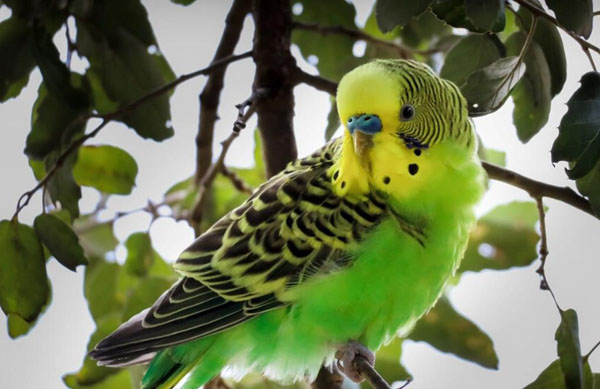Melopsittacus undulatus
IUCN
LCBasic Information
Scientific classification
- name:Melopsittacus undulatus
- Scientific Name:Melopsittacus undulatus,Budgerigar、Budgie,Jiao Feng, Cai Feng, Asu Er, Parrot
- Outline:Climbing birds
- Family:Psittaciformes Psittacidae Budgerigar
Vital signs
- length:10-20cm
- Weight:30-35g
- lifetime:7-10years
Feature
It has a lively temperament and is easy to tame, and is one of the most popular pet birds in our country.
Distribution and Habitat
Originally from Oceania, it is widely distributed in the inland areas of Australia, the coastal areas of the east, southwest and northern provinces, and a few are distributed in Cape York Peninsula and Tasmania.
It mainly inhabits the dry inland areas of Australia, and is occasionally found in semi-arid and semi-humid areas. Some groups have seasonal migration behavior and like to move in grasslands, bushes, riverside woodlands, and farm fields.
Appearance
The head and back feathers of budgies are usually yellow with black stripes. The color and stripes are like tiger skin, so they are called budgies. The head is round, the beak is hooked, and there is a wax film above the beak (the gender of most budgies can be distinguished by the color of the wax film).
Details
Budgies are the most common pet birds in the world. They come in many varieties, are playful and cute, and are widely loved by the public. The total number of budgies in the world exceeds 5 million. They are often the first parrots bought by many people who are just interested in parrots. They are also the most common species in bird shows. Since the Australian biologist Guigmand made a major discovery and breakthrough in genetic engineering in 1860, the variants of various budgies have entered an unprecedented diversity, with a total of thousands of variants. In addition, they are very easy to care for and breed, so they are so common. In my country, it is one of the most popular pet birds.

They are gregarious birds, usually gathering in groups of 20 or even hundreds, with a record of gatherings of 25,000. If disturbed, the entire flock will take off, circle in the air and suddenly fly in an undirected manner, before landing on a tree at a safe distance. They are quite sociable, and usually each bird has its own position in the group, with no hierarchy, though quarrels may occur occasionally. At dawn, they will first go to the water source to drink, and then go for food. At midday, when it is hot, they will seek to rest under the dense shade of trees, and at sunset, they will go to the water source to drink, and then go to the water source to look for food. They continue to forage when it is cooler in the afternoon, and the whole group will start to return to the nest to rest for the night at dusk; they like to forage on the ground during the day, and because their feathers blend into the surrounding environment, they are quite difficult to detect; they are very friendly by nature and are not afraid of people, and can be observed at close range; they mostly go to the troughs, ponds, rivers, and puddles on the ground where cattle and sheep drink water, and usually the whole group will drink water quickly together to avoid being preyed on by predators; they usually do not have a fixed route for foraging, but search everywhere in a nomadic manner.
Budgies can breed at any time of the year, but most often occur when large quantities of seeds are sown.

There are many varieties of artificially bred budgies, and the colors range from light to dark: white, creamy white, yellow, bright green, dark green, olive green, gray-green, sky blue, cobalt blue, dark blue, light violet, violet, gray, and carbon black.
1. Wavy budgies Domestically raised budgies basically belong to this category. The body feather color pattern is similar to the original species, with blue, yellow, green and other colors, and the upper body is covered with black horizontal stripes.
2. Light-colored budgies can be divided into two strains: yellow upper body, green abdomen and white upper body, blue abdomen, both with black spots on the wings (some do not).
3. Jade-headed budgies: one has a white head and the rest of the body is light blue; the other has a yellow head and the rest of the body feathers are green.
4. Albino budgies have pure white feathers and red eyes, called white-red-eyed budgies. There is also a type with white body feathers and large black spots all over the body, called clouded budgies.
5. The yellow budgie has yellow body feathers and red eyes, which is called yellow-red eyed budgie.
Budgies are easy to raise and manage, can tolerate roughage, have a strong physique, are not prone to illness, and are easy to breed. Budgies have hooks on their beaks, are strong and powerful, and like to chew wood, so they cannot be raised in bamboo cages, but in metal cages. As leisure ornamental birds, they can be raised in small electroplated metal cages, which are equipped with perches and rings for parrots to play with.








